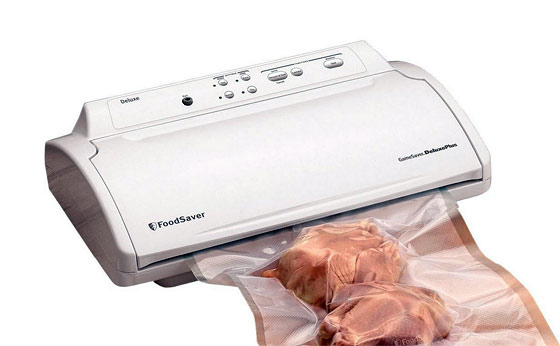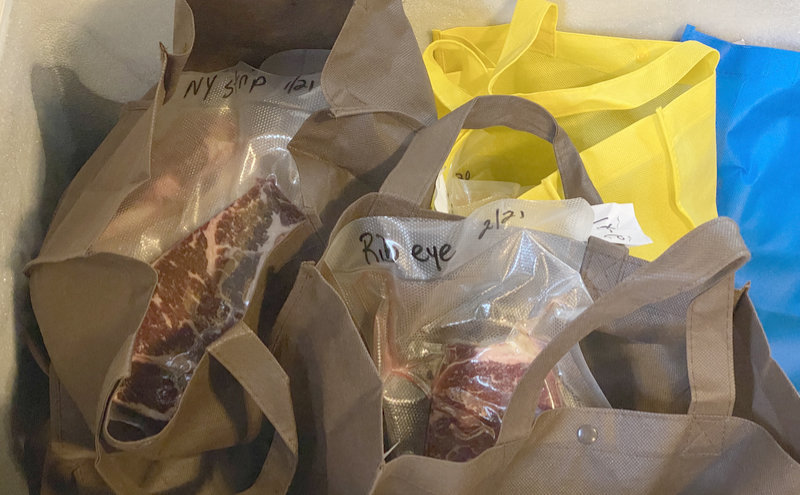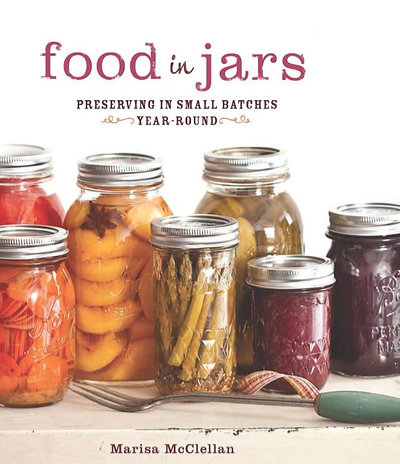Vacuum Sealer Uses – Things You Can Seal With A Food Saver Machine

The best Food Saver machine (vacuum sealer) is whichever one that you have! They’re great! (pretty much regardless of brand since they’re all so similar in operation). Read to the bottom for the best prices I’ve found on vacuum seal bags!
The ‘Food Saver’ machine, combined with specially-designed bags (or rolls) may preserve some foods up to 5 times longer than zipper bags (Ziploc) or other ordinary containers (in the fridge or freezer).
“Food Saver” has become synonymous with the “vacuum sealer” machine. Many people refer to these as a “Food Saver” vacuum sealer because they were first with market share long ago.
Today there are lots of brands to choose from. The way they work is essentially the same: Suck out the air from the special-designed bag for longer shelf life – no oxidation damage or freezer burn – and a better tasting result!
It’s great as a survival food vacuum sealer. A kitchen appliance tool with all sorts of multiple uses beyond just sealing food. Some more uses listed below (and in the comments).
Lets get your input for the many things that you can seal with a Food Saver vacuum sealer machine as it may apply to your own experiences.
Things to Vacuum Seal with a Food Saver Machine
Obviously it was originally designed to seal foods for keeping in the fridge or freezer.
Vacuum Seal Meat!!
I will say this regarding food and vacuum sealers: It significantly helps with preserving meat in the freezer! Vacuum seal bags eliminate freezer burn. Zero oxidation results in much better taste when thawed and cooked!
Buy when on sale! Prices will only keep going up…so it makes practical sense.
After sealing we write the month/year on the bag and the type of meat before putting into the chest freezer.

Home Dehydrated Foods
There’s a great attachment to use for sealing canning jars containing dehydrated foods. It’s a “Jar Sealer” accessory. Place dehydrated food in the jar. Place lid, and ring (screw on ring till barely snug, then back off a hair). Attach accessory to hose and machine. Place accessory over the jar. Engage. Done.
It’s common to dehydrate vegetables from the garden such as peppers, onions, (whatever!), and store them in glass mason jars. You greatly extend the shelf life by pulling the air out of the jars:
Regular Mouth and Wide Mouth Jar Sealer Attachment Kit:
(view on amzn)
Note: These accessories requires a machine that can accommodate an external hose accessory.
FoodSaver Machine (comes with external hose)
Tip: We use ( this ) very handy jar lid opener when accessing our dehydrated foods (and our home canned foods). This way you avoid damaging the lid. And it’s just easier!
[ Read: Dehydrating Onions ]
[ Read: NESCO Food Dehydrator (article) ]
Herbs & Spices
Spices are a LOT cheaper if you buy them in bulk. You may receive them already vacuum sealed. But if not, you can do it yourself! It really helps to preserve flavor over time.
Seal Fire-starter & Fire-making Supplies
Ordinarily I keep my mini firestarter kits in a Ziploc bag. But you might choose to use a vacuum seal bag for a kit on a boat or environment that you know will be wet.
Vacuum Seal Clothing
It compresses well. Nice to have dry socks and other basic clothing necessities in a GHB or other related kit or backpack.
Emergency Food Snacks
Vacuum sealing food bars or candy bars or other emergency snacks will increase the shelf life. Great for a survival kit to supplement other foods.
Toilet Paper for your Emergency Kit
Take a roll of TP and vacuum seal it in a bag. It will shrink a good bit. Use a vacuum seal bag larger than the roll so you can reuse it afterwards to store what’s left.
Canoe | Kayak | Boat Supplies
Seal whatever it is that you want to stay dry on your trip!
Paper Money
Can you vacuum seal paper money? Although paper money can withstand some harsh wet conditions (i.e. the washing machine?), for long term storage of your ‘loot’, you might vacuum seal your stacks… (and hide them in the freezer?) ;)
Long term Gun storage
How about vacuum sealing a gun for long term storage? Properly oil first, wrap with oil damp rag, then vacuum seal.
Do you have more ideas for using a Food Saver vacuum seal machine?
Here’s a popular book that I purchased some years ago. “Food in Jars” by Marisa McClellan.
Food in Jars – Preserving in Small Batches Year Round
(amzn)

BEST PRICE VACUUM SEAL BAGS
As of this post update, these are the lowest cost per bag that I’ve found. I’ve been using them for some time with not issues. I use the pint size bags for some of our garden peppers (sliced, bagged, and in the chest freezer). Quart size is perfect for a pound of ground beef (we buy bulk on sale) – in the chest freezer. Some steaks fit in there too. The big Cowboy Steaks need the gallon size!
[ Read: How I Organize My Chest Freezers ]
